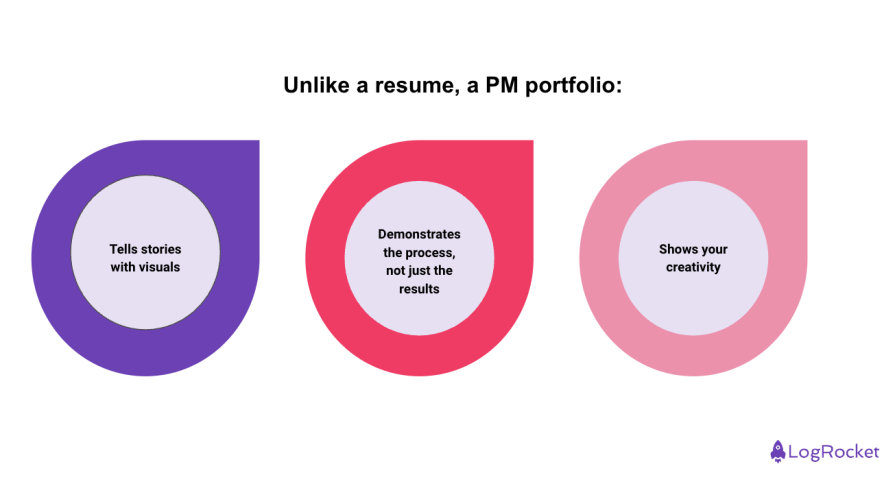As a product manager, you may have the skills and experience, but how do you showcase them effectively? Standing out in a competitive landscape can be tough. However, a product manager portfolio is a powerful, often overlooked tool that tells your story and demonstrates your impact and problem-solving skills.

Whether you’re aiming for a top-tier tech company or breaking into the field for the first time, crafting a compelling portfolio is a chance to show, not just tell, why you’re the right fit. This article provides you with a guide to creating a product manager portfolio, including why to create one, how it differs from a resume, and its key components.
A portfolio brings your problem-solving approach to life. It provides tangible evidence of how you navigate complex challenges, prioritize solutions, and deliver impact. Besides that, a PM portfolio helps you:
Showcasing work samples is one of the most compelling aspects of a PM portfolio. It gives potential employers a hands-on look at real artifacts you’ve created like product roadmaps, wireframes, user research reports, A/B testing analyses, or launch plans. These samples add credibility and offer a direct glimpse into your work style, attention to detail, and how you execute product strategies from concept to launch.
Numbers speak louder than words. A portfolio lets you showcase the metrics that matter — revenue growth, increased user engagement, or improved retention. It’s a visual representation of the results you’ve driven.
Portfolios are still relatively uncommon among PMs. Hence, a PM portfolio is a unique asset that can help you stand out. It signals to hiring managers that you are serious about your craft and willing to go the extra mile.
You can use resumes and portfolios to showcase your experience. However, each differs in its approach.

A resume is primarily text-based and offers a high-level overview of your work experience, focusing on roles, responsibilities, and achievements, usually in bullet points. On the other hand, a portfolio provides visuals and goes deeper into specific projects, providing context, your thought process, and results. It’s like an expanded case study of your most impactful work.
Your resume focuses on outcomes, using metrics and achievements to highlight success. On the other hand, a portfolio dives into how you arrived at those results, highlighting your strategic thinking, prioritization framework, user research methods, stakeholder management, and decision-making. It’s a chance to show how you got to the end result, not just what you achieved.
A resume is often a static document following a formal structure. A portfolio is a two-way tool that invites discussion. It’s interactive and can be used to drive meaningful conversations in interviews. Also, the format of a portfolio can be more flexible and creative.
A strong PM portfolio includes a variety of artifacts that represent your work, skills and thought process. Here are some of the artifacts to consider including in your PM portfolio:
By including a mix of these artifacts, you can create a well-rounded PM portfolio that showcases both the strategic and tactical aspects of your product management journey.
Here are the key dos and don’ts to keep in mind when creating your product manager (PM) portfolio:
When applying, be sure to include the link of your portfolio in your resume and applications. A PM portfolio can be your secret weapon in interviews.
In the behavioral interviews, you can use your portfolio to illustrate responses to common questions like, “Tell me about a time you launched a successful product.” Let the portfolio act as supporting evidence. If the interviews are conducted online, make sure you have your portfolio ready to share on screen.
At the end of the interview, summarize how the projects in your portfolio align with the role you’re applying for. Reinforce your interest and show that your experience is a natural fit for the company’s needs.
Creating a product manager portfolio is more than just a checkbox on your job search to-do list—it’s a reflection of your journey, skills, and impact. You’re telling a compelling story about your ability to solve real problems and deliver results. With the right blend of creativity, clarity, and strategy, your PM portfolio can be the key to unlocking new career opportunities.
Featured image source: IconScout

LogRocket identifies friction points in the user experience so you can make informed decisions about product and design changes that must happen to hit your goals.
With LogRocket, you can understand the scope of the issues affecting your product and prioritize the changes that need to be made. LogRocket simplifies workflows by allowing Engineering, Product, UX, and Design teams to work from the same data as you, eliminating any confusion about what needs to be done.
Get your teams on the same page — try LogRocket today.

Promotions depend on proof. This guide shows PMs how to capture wins, feedback, and impact before review season.

Most teams fail at autonomy. Learn how clear rules help product teams move faster without micromanagement.

A practical framework for PMs to use AI in ideation without sacrificing judgment, strategy, or decision quality.

A practical five minute revenue estimation method to help product managers compare ideas, drop low impact features, and prioritize smarter.